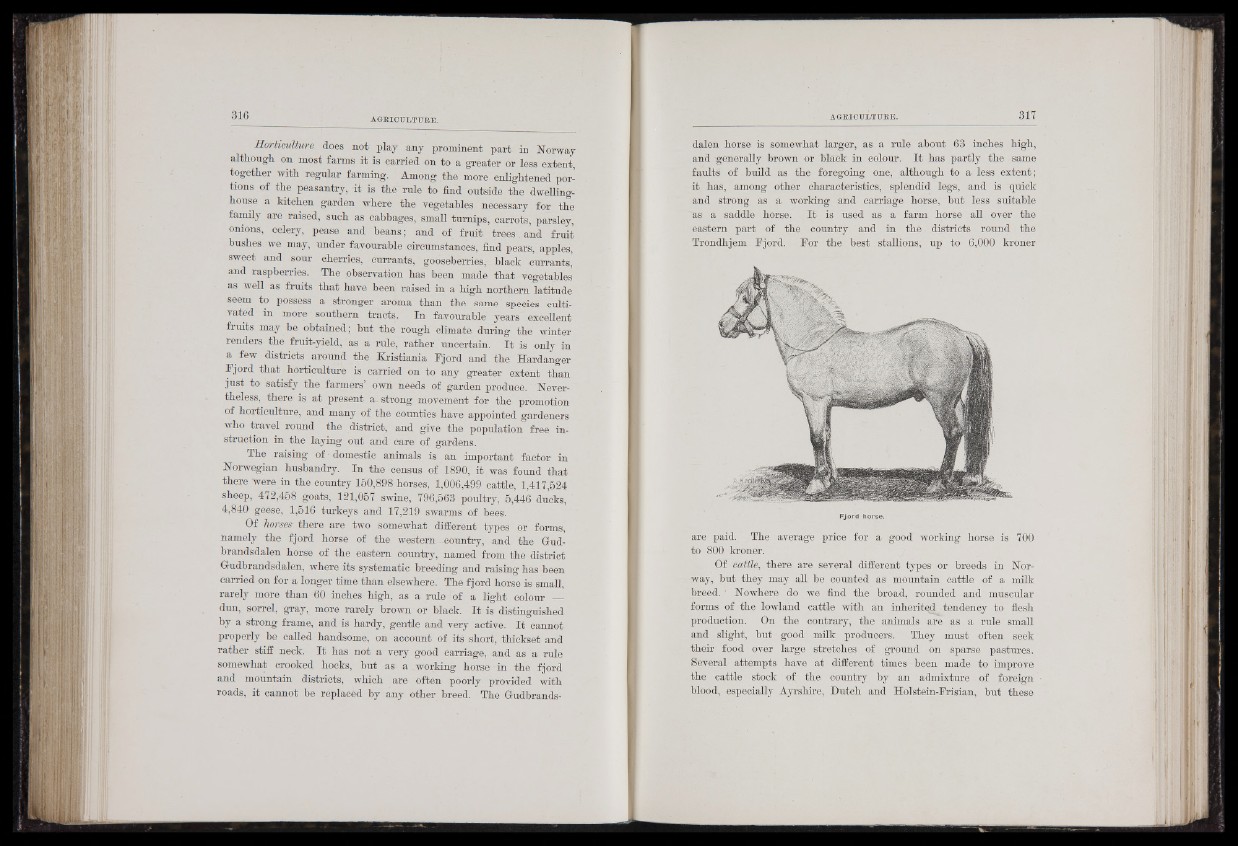
Horticulture does not play any prominent part in Norway
although on most farms it is carried on to a greater or less extent,
together with regular farming. Among the more enlightened portions
of the peasantry, it is the rule to find outside the dwelling-
house a kitchen garden where the vegetables necessary for the
family are raised, such as cabbages, small turnips, carrots, parsley,
onions, celery, pease and beans; and of fruit trees. and fruit
bushes, we may, under favourable circumstances, find pears, apples,
sweet and sour cherries, currants, gooseberries, black currants,’
and raspberries. The observation has been made that vegetables
as well as fruits that have been raised in a high northern latitude
seem to possess a stronger aroma than the same species cultivated
in more southern tracts. In favourable years excellent
fruits may be obtained; but the rough climate during the winter
renders the fruit-yield, as a rule, rather uncertain. I t is only in
a few districts around the Kristiania Fjord and the Hardanger
Fjord that horticulture is carried on to any greater extent than
just to satisfy the farmers’ own needs of garden produce. Nevertheless,
there is at present a. strong movement for the promotion
of horticulture, and many of the counties have appointed gardeners
who travel round the district, and give the population free instruction
in the laying out and care of gardens.
The raising of • domestic animals is an important factor in
Norwegian husbandry. In the census of 1890, it was found that
there Were in the country 150,898 horses, 1,006,499 cattle, 1,417,524
sheep, 472,458 goats, 121,057 swine, 796,563 poultry, 5,446 ducks,
4,840 geese, 1,516 turkeys and 17,219 swarms of bees.
Of horses there are two somewhat different types or forms,
namely the fjord horse of the western -country, and the Gud-
brandsdalen horse of the eastern country, named from the district
Gudbrandsdalen, where its systematic breeding and raising has been
carried on for a longer time than elsewhere. The fjord horse is small,
rarely more than 60 inches high, as a rule ;of a light colour
dim, sorrel, gray, more rarely brown or black. I t is distinguished
by a strong frame, and is hardy, gentle and very active. I t cannot
properly be called handsome, on account of its short, thickset and
rather stiff neck. I t has not a very good carriage, and as a rule
somewhat crooked hocks, but as a working horse in the fjord
and mountain districts, which are often poorly provided with
roads, it cannot be replaced by any other breed. The Gudbrandsare
dalen horse is somewhat larger, as a rule about 63 inches high,
and generally brown or black in colour. I t has partly the same
faults of build as the foregoing one, although to a less extent;
it has, among other characteristics,, splendid legs, and is quick
and strong as a working and carriage horse, but less suitable
as a saddle horse. It is used as a farm horse all over the
eastern part of the country and in th e . districts round the
Trondhjem Fjord. For the best stallions, up to 6,000 kroner
Fjord horse.
paid. , The average price for a good working horse is 700
to 800 kroner.
Of cattle, there are several different types or breeds in Norway,
but they may all be counted as mountain cattle of a milk
breed. ' Nowhere do we find the broad, rounded and muscular
forms of the lowland cattle with an inherited tendency to flesh
production. On the contrary, the animals are as a rule small
and slight, but good milk producers. They must often seek
their food over large stretches of ground on sparse pastures.
Several attempts have at different times been made to improve
the cattle stock of the country by an admixture of foreign
blood, especially Ayrshire, Dutch and Holstein-Frisian, but these